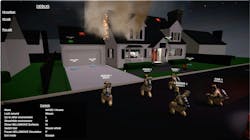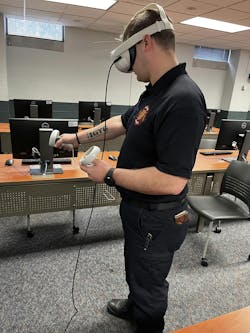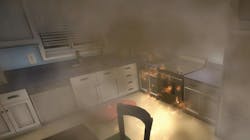Virtual reality (VR) has arrived in the fire service as a transformative tool for enhancing training effectiveness and realism. Immersing students in a virtual environment that’s a familiar setting, such as a building that’s in their response district or a tank car, is a valuable way to develop the skills that are needed to be successful while commanding and functioning on scene.
Although some accept modern technology, others still are skeptical and need convincing. My experience in modernizing simulation training has been extremely rewarding. I am optimistic that with more understanding and hands-on experience using VR, skeptics can become believers.
Buy-in
Training officers and a department’s fire instructor cadre generally are the ones who bring new ideas to a department. Often, a new idea is met with resistance or opposition because of the competition for budget dollars. Furthermore, decision-makers are by nature risk-averse, and VR simulation might seem less of a critical need and more of a video game pastime to the ill-informed.
To create buy-in, decision-makers must understand how VR simulation enhances hands-on training. VR isn’t a replacement for hands-on training, but it does require one’s hands and the completion of tasks.
Just like hands-on training, simulations provide a means to develop skills through repetition. The difference is that VR simulation training can take place virtually anywhere, across jurisdictions, and allow units to remain in their response district. Scheduled hands-on training might be at risk of cancellation because of weather; VR simulations allow for delivery through rain, sleet or snow. VR simulations are tools that help to develop such skills as hazard recognition, decision-making, communication, adherence to standard operating guidelines and standard operating procedures, and equipment familiarization. When viewed through this lens, VR simulations can become a more accepted form of fire service training.
Implementation
Simulations in the fire service are ranked routinely as the most engaging and fun training. The use of simulators and props has been used widely for years in emergency vehicle driving, forcible entry and incident command training. VR allows firefighters to engage in realistic, immersive training scenarios that replicate various emergencies, such as structure fires, hazmat incidents, command and control, and rescue operations. This immersion helps trainees to experience the intensity and urgency of real-life situations without the associated risks of injury and exposure to toxins.
Schools and colleges now use VR to immerse students in real-world simulations to help to educate and prepare them for the workforce. I was fortunate to be on a team that brought 2D simulations to fire service training at The University of Missouri’s Fire and Rescue Training Institute (MU FRTI). The original course, “Simulations for the First-Arriving Officer,” helped to prepare first-arriving officers to make initial fireground decisions. Since the initial program, MU FRTI transitioned to using VR to immerse students in a more realistic environment. The positive student reviews show that VR is an effective means to prepare fire officers to make procedural-based decisions that lead to positive outcomes.
Student engagement
I have found that students who are unfamiliar with gaming controls are reluctant to participate and normally become spectators. However, when they are immersed in a VR environment, their reluctance to participate diminishes. That said, individuals adapt to simulation training at varying rates based on their preferred learning styles. Some might thrive in immersive environments, while others might need more time to adjust. Users who have experience in gaming or other interactive technologies might find the transition to VR easier than those who are less familiar with such environments. I have found that once a student dons the headset, distractions, such as a smartphone, are eliminated, which allows the student to be fully involved in the scenario.
Of course, the goal of training firefighters is to improve job performance. Immersing students in a simulation that imitates a real-life environment allows for a more realistic atmosphere. Students then use the visual cues to make fireground decisions, communicate orders to other students and then analyze the results.
Furthermore, VR training systems provide instant feedback on performance, which helps students to identify areas for improvement. Understanding and effectively using this feedback can enhance the learning curve. The ability to replay scenarios allows firefighters to learn from those scenarios and refine their techniques, to promote a culture of continuous improvement.
Learning in VR also can involve collaboration with peers, presenting a social element. Working together in virtual environments enhances teamwork skills.
Applications
The uses of VR in fire service training are endless. Training for incident command, communications, fireground operations and hazmat response are obvious applications for immersive simulations. Here are four less obvious opportunities:
Firefighter recruitment. Departments can set up VR stations at career fairs and public events, to offer potential candidates a chance to experience the job of a firefighter. Using VR as a firefighter recruitment tool can be highly effective in attracting potential candidates, engaging them and providing realistic experiences that highlight the challenges and excitement of the profession.
Behavioral health. Utilizing VR to prepare firefighters for the psychological aspects of their jobs is showing promise. Simulations can help firefighters to develop coping strategies and resilience, to address mental health challenges that exist within the fire service. Future VR training might incorporate built-in debriefing tools, to allow firefighters to reflect on their experiences and emotions in a safe environment, to promote mental well-being.
Multidiscipline. Multi-user VR scenarios can facilitate collaborative training exercises that involve multiple agencies (fire, police, EMS) that work together in a variety of environments. Training environments that involve medical emergencies, hazmat incidents and active-shooter scenarios can improve interagency communication and coordination during real-life emergencies.
Community involvement. Leveraging VR to engage the community by simulating fire safety education scenarios allows members of the public to understand how to respond to emergencies, thus enhancing community preparedness.
What the future holds
The future of VR in the fire service is poised for significant growth and innovation, driven by advancements in technology, changing training needs, and a greater emphasis on safety and efficiency. Here are three ideas regarding the future of VR in the fire service:
Technology advancements. As technology improves, simulations will become even more realistic, incorporating advanced graphics, physics and environmental effects. This will allow firefighters to train in increasingly complex and lifelike scenarios, such as multistory building fires and large-scale disasters. Future VR training likely will include adaptive scenarios in which environmental variables change in real time, to challenge firefighters to think and react quickly to evolving situations.
Augmented reality. The combination of VR with augmented reality (AR) technologies could enhance training and operational capabilities. For example, AR could overlay critical information in real time during VR simulations, to help firefighters to understand the environment better and to make informed decisions.
Introducing artificial intelligence (AI) into scenarios allows a more responsive and intelligent training environment, providing realistic challenges that adapt based on a trainee’s performance and decision-making.
Analytics. The use of data analytics in VR training will allow departments to track and analyze performance metrics, to provide insights into individual and team effectiveness. These data can inform training programs and help to identify areas for improvement. Leveraging analytics will enable customized training experiences that are tailored to individual needs, to ensure that firefighters focus on areas that require the most attention.
Both, not one or the other
Both VR and hands-on training have distinct advantages and challenges. A blended approach that combines the strengths of both methods often is the most effective strategy. VR can serve as a complementary tool to enhance hands-on training by providing additional practice opportunities, safety and scenario variability, while hands-on training remains essential for developing the physical skills and team dynamics that are necessary for effective firefighting.
As technology advances, the integration of VR into training programs likely will become more prevalent, which will allow the fire service to maximize the benefits of both training methods.

Mike Novak
Mike Novak is the division chief of training and safety for Branson, MO, Fire Rescue. His areas of responsibility with Branson include training program management as well as health and incident safety. Novak serves as the Region 7 Volunteer Advocate Manager for the National Fallen Firefighters Foundation’s Everyone Goes Home program, an adjunct instructor for the University of Missouri's Fire Rescue Training Institute, and a regional sales and training associate with Pleiadian Systems. He holds a master’s degree in public administration in emergency services administration and is credentialed as a Chief Fire Officer through the Center for Public Safety Excellence and as an Executive Fire Officer through the National Fire Academy. He presented on VR training at the inaugural FireFusion conference in November 2024.




